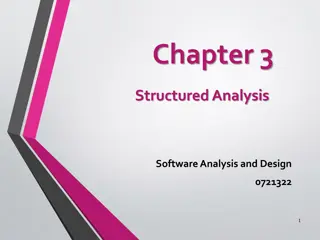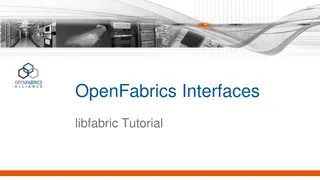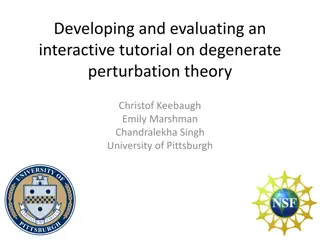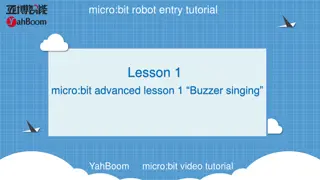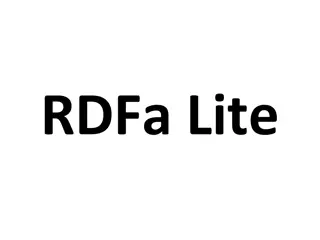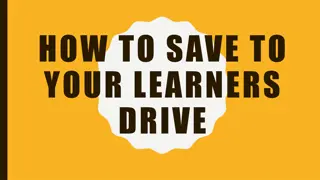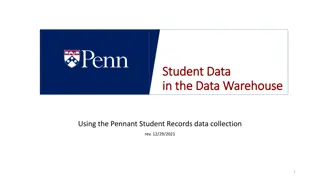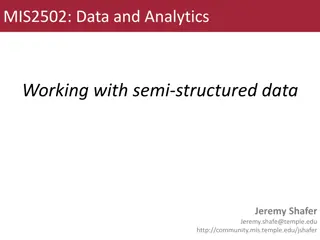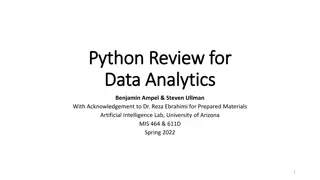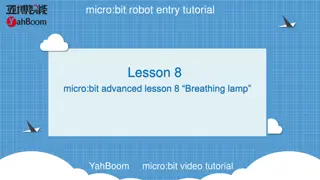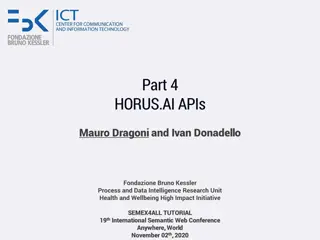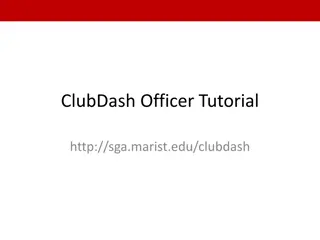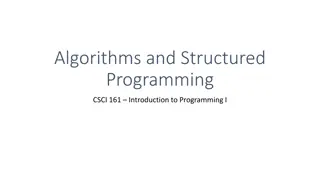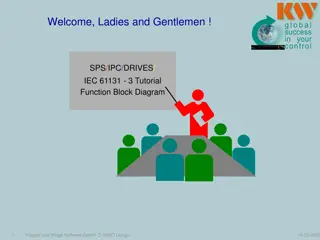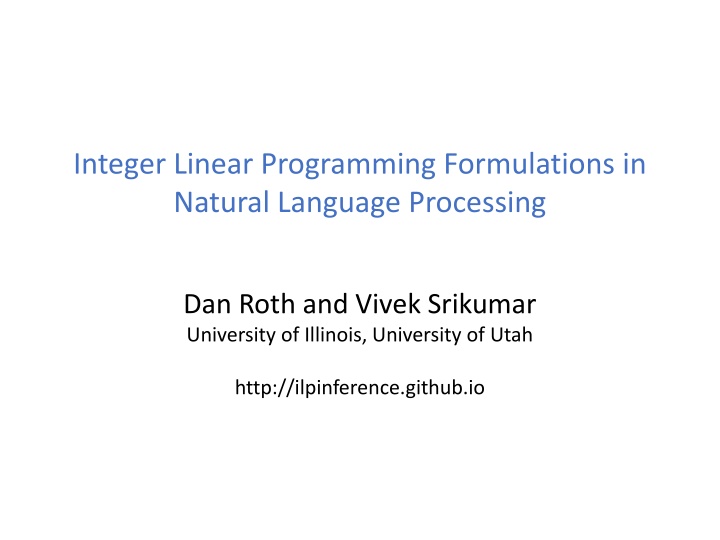
ILP Formulations in NLP: Applications and Methods Revealed
Explore the world of Integer Linear Programming (ILP) formulations in Natural Language Processing (NLP) with Dan Roth and Vivek Srikumar. Discover the introduction, applications, modeling, and training paradigms of ILP in NLP, along with joint inference techniques and more. Dive into examples, problem formulations, learning methods, and inference insights in this informative guide.
Download Presentation

Please find below an Image/Link to download the presentation.
The content on the website is provided AS IS for your information and personal use only. It may not be sold, licensed, or shared on other websites without obtaining consent from the author. If you encounter any issues during the download, it is possible that the publisher has removed the file from their server.
You are allowed to download the files provided on this website for personal or commercial use, subject to the condition that they are used lawfully. All files are the property of their respective owners.
The content on the website is provided AS IS for your information and personal use only. It may not be sold, licensed, or shared on other websites without obtaining consent from the author.
E N D
Presentation Transcript
Integer Linear Programming Formulations in Natural Language Processing Dan Roth and Vivek Srikumar University of Illinois, University of Utah http://ilpinference.github.io
Nice to Meet You 2 Roth & Srikumar: ILP formulations in Natural Language Processing
ILP Formulations in NLP Part 1: Introduction [30 min] Part 2: Applications of ILP Formulations in NLP [15 min] Part 3: Modeling: Inference methods and Constraints [45 min] BREAK Part 4: Training Paradigms [30 min] Part 5: Constraints Driven Learning [30 min] Part 6: Developing ILP based applications [15min] Part 7: Final words [15min] 3 Roth & Srikumar: ILP formulations in Natural Language Processing
PART 1: INTRODUCTION 4 Roth & Srikumar: ILP formulations in Natural Language Processing
ILP Formulations in NLP Part 1: Introduction [30 min] Motivation Examples: NE + Relations Vision Additional NLP Examples Problem Formulation Constrained Conditional Models: Integer Linear Programming Formulations Initial thoughts about learning Learning independent models Constraints Driven Learning Initial thoughts about Inference 5 Roth & Srikumar: ILP formulations in Natural Language Processing
Joint Inference with General Constraint Structure [Roth&Yih04,07,.] Recognizing Entities and Relations Joint inference gives good improvement other other other other other other other 0.05 0.05 0.10 0.10 0.05 0.05 0.05 per per per per per per per 0.85 0.85 0.60 0.60 0.50 0.50 0.50 loc loc loc loc loc loc loc 0.10 0.10 0.30 0.30 0.45 0.45 0.45 Key Questions: How to learn the model(s)? What is the source of the knowledge? How to guide the global inference? Bernie s wife, Jane, is a native of Brooklyn E1 E2 E3 R12 R23 irrelevant irrelevant irrelevant irrelevant irrelevant 0.05 0.05 0.05 0.10 0.10 spouse_of spouse_of spouse_of spouse_of spouse_of 0.45 0.45 0.45 0.05 0.05 born_in born_in born_in born_in born_in 0.50 0.50 0.50 0.85 0.85 Models could be learned separately/jointly; constraints may come up only at decision time. 6 Roth & Srikumar: ILP formulations in Natural Language Processing
Pipeline Most problems are not single classification problems Raw Data POS Tagging Phrases Semantic Entities Relations Parsing WSD Semantic Role Labeling Either way, we need a way to learn models and make predictions (inference; decoding) that assign values to multiple interdependent variables Conceptually, Pipelining is a crude approximation Interactions occur across levels and down stream decisions often interact with previous decisions. Leads to propagation of errors Occasionally, later stages could be used to correct earlier errors. But, there are good reasons to use pipelines Reusability of components; not putting everything in one basket How about choosing some stages and thinking about them jointly? 7 Roth & Srikumar: ILP formulations in Natural Language Processing
Example 2: Object detection How would you design a predictor that labels all the parts using the tools we have seen so far? handle bar saddle/seat Right facing bicycle right wheel left wheel Photo by Andrew Dressel - Own work. Licensed under Creative Commons Attribution-Share Alike 3.0 8 Roth & Srikumar: ILP formulations in Natural Language Processing
One approach to build this structure Left wheel detector: Is there a wheel in this box? Binary classifier 1. (Left) wheel detector Final output: Combine the predictions of these individual classifiers (local classifiers) 2. (Right) wheel detector The predictions interact with each other Eg: The same box can not be both a left wheel and a right wheel, handle bar does not overlap with seat, etc 3. Handle bar detector Need inference to compose the output 4. Seat detector Photo by Andrew Dressel - Own work. Licensed under Creative Commons Attribution-Share Alike 3.0 9 Roth & Srikumar: ILP formulations in Natural Language Processing
Task of Interests: Structured Output For each instance, assign values to a set of variables Account for the fact that output variables depend on each other Common NLP tasks Parsing; Semantic Parsing; Summarization; Co-reference Common Information Extraction Tasks: Entities, Relations, Common Vision Task: Parsing objects; scene segmentation and interpretation, . Many pure machine learning approaches exist Hidden Markov Models (HMMs); CRFs [ there are special cases ] Structured Perceptrons and SVMs [ to be discussed later] However, 10 Roth & Srikumar: ILP formulations in Natural Language Processing
Information Extraction without Output Expectations Lars Ole Andersen . Program analysis and specialization for the C Programming language. PhD thesis. DIKU , University of Copenhagen, May 1994 . Small #(examples) Prediction result of a trained HMM Lars Ole Andersen . Program analysis and specialization for the C Programming language . PhD thesis . DIKU , University of Copenhagen , May 1994 . [AUTHOR] [TITLE] [EDITOR] [BOOKTITLE] [TECH-REPORT] [INSTITUTION] [DATE] Violates lots of natural constraints! 11 Roth & Srikumar: ILP formulations in Natural Language Processing
Strategies for Improving the Results (Standard) Machine Learning Approaches Higher Order HMM/CRF? NN? Increasing the model complexity Increasing the window size? Increase difficulty of Learning Adding a lot of new features Requires a lot of labeled examples What if we only have a few labeled examples? Can we keep the learned model simple and still make expressive decisions? Instead: Constrain the output to make sense satisfy our output expectations Push the (simple) model in a direction that makes sense minimally violates our expectations. 12 Roth & Srikumar: ILP formulations in Natural Language Processing
Expectations from the output (Constraints) Each field must be a consecutive list of words and can appear at most once in a citation. State transitions must occur on punctuation marks. The citation can only start with AUTHOR or EDITOR. The words pp., pages correspond to PAGE. Four digits starting with 20xx and 19xx are DATE. Quotations can appear only in TITLE . Easy to express pieces of knowledge Non Propositional; May use Quantifiers 13 Roth & Srikumar: ILP formulations in Natural Language Processing
Information Extraction with Expectation Constraints Adding constraints, we get correct results! Without changing the model [AUTHOR] [TITLE] [TECH-REPORT] [INSTITUTION] [DATE] Lars Ole Andersen . Program analysis and specialization for the C Programming language . PhD thesis . DIKU , University of Copenhagen , May, 1994 . We introduce the Constrained Conditional Models formulation which allows: Learning a simple model Making decisions with a more complex model Some of the structure imposed externally/declaratively Accomplished by directly incorporating constraints to bias/re-rank decisions made by the simpler model 14 Roth & Srikumar: ILP formulations in Natural Language Processing
Constrained Conditional Models Any MAP problem w.r.t. any probabilistic model, can be formulated Penalty for violating the constraint. as an ILP [Roth+ 04, Taskar 04] Variables are models y = argmaxy 1 (x,y)wx,y subject to Constraints C(x,y) y = argmaxy 2 Y wT (x, y) + uTC(x, y) Knowledge component: (Soft) constraints Weight Vector for local models Features, classifiers (Lin; NN); log-linear models (HMM, CRF) or a combination How far y is from E.g., an entities model; a relations model. a legal/expected assignment Training: learning the objective function (w, u) Decouple? Decompose? Force u to model hard constraints? Inference: A way to push the learned model to satisfy our output expectations (or expectations from a latent representation) How? [CoDL, Chang, Ratinov, Roth (07, 12); Posterior Regularization, Ganchev et. al (10); Unified EM (Samdani & Roth(12), dozens of applications in NLP] The benefits of thinking about it as an ILP are conceptual and computational. 15 Roth & Srikumar: ILP formulations in Natural Language Processing
The 2nd and 3rd parts of the tutorial are on how to model and do inference Examples: CCM Formulations The 4th and 5th parts of the tutorial are on how to learn y = argmaxy 2 Y wT (x, y) + uTC(x, y) While (x, y) and C(x, y) could be the same; we want C(x, y) to express high level declarative knowledge over the statistical models. Formulate NLP Problems as ILP problems (inference may be done otherwise) 1. Sequence tagging (HMM/CRF + Global constraints) 2. Sentence Compression (Language Model + Global Constraints) 3. SRL (Independent classifiers + Global Constraints) Sequential Prediction Sentence Compression/Summarization: Language Model based: Argmax ijk xijk Accomplished by incorporating constraints to bias/re-rank global decisions to satisfy (minimally violate) expectations. Knowledge/Linguistics Constraints Knowledge/Linguistics Constraints Constrained Conditional Models Allow: Decouple complexity of the learned model from that of the desired output Learn a simple model (multiple; pipelines); reason with a complex one. HMM/CRF based: Argmax ij xij Cannot have both A states and B states in an output sequence. If verb is chosen, include its arguments If a modifier chosen, include its head 16 Roth & Srikumar: ILP formulations in Natural Language Processing
Archetypical Information Extraction Problem: E.g., Concept Identification and Typing, Event Identification, etc. Semantic Role Labeling (SRL) I left my pearls to my daughter in my will . [I]A0left [my pearls]A1 [to my daughter]A2 [in my will]AM-LOC . A0 Leaver Things left Benefactor A1 A2 AM-LOC Location I left my pearls to my daughter in my will . 17 Roth & Srikumar: ILP formulations in Natural Language Processing
Algorithmic Approach Learning Based Java: allows a developer to encode constraints in First Order Logic; these are compiled into linear inequalities automatically. No duplicate I left my nice pearls to her candidate arguments argument classes Identify argument candidates Unique labels Pruning [Xue&Palmer, EMNLP 04] Argument Identifier Binary classification Variable ya,t indicates whether candidate argument a is assigned a label t. ca,t is the corresponding model score Classify argument candidates Argument Classifier Multi-class classification I left my nice pearls to her [ [ [ [ [ ] ] ] ] ] I left my nice pearls to her Inference Use the estimated probability distribution given by the argument classifier argmax a,tya,tca,t = a,t1a=tca=t Subject to: One label per argument: tya,t = 1 No overlapping or embedding Relations between verbs and arguments, . Use structural and linguistic constraints One inference problem for each verb predicate. Infer the optimal global output I left my nice pearls to her Use the pipeline architecture s simplicity while maintaining uncertainty: keep 18 Roth & Srikumar: ILP formulations in Natural Language Processing probability distributions over decisions & use global inference at decision time.
Semantic Role Labeling (SRL) I left my pearls to my daughter in my will . 0.5 0.05 0.15 0.1 0.15 0.2 0.15 0.05 0.1 0.6 0.6 0.05 0.1 0.05 0.05 0.7 0.05 0.05 0.3 0.05 0.15 0.2 0.2 0.1 0.2 19 Roth & Srikumar: ILP formulations in Natural Language Processing
Semantic Role Labeling (SRL) I left my pearls to my daughter in my will . 0.5 0.05 0.15 0.1 0.15 0.2 0.15 0.05 0.1 0.6 0.6 0.05 0.1 0.05 0.05 0.7 0.05 0.05 0.3 0.05 0.15 0.2 0.2 0.1 0.2 20 Roth & Srikumar: ILP formulations in Natural Language Processing
Semantic Role Labeling (SRL) I left my pearls to my daughter in my will . 0.5 0.05 0.1 0.2 0.6 0.05 0.15 0.15 0.15 0.05 0.1 0.6 0.05 0.1 0.05 0.7 0.05 0.05 0.3 0.05 0.15 0.2 0.2 0.1 0.2 21 Roth & Srikumar: ILP formulations in Natural Language Processing
The tutorial web page will point to material on how to write down linear inequalities for various logical expressions [details later]. Constraints Any Boolean rule can be encoded as a set of linear inequalities. No duplicate argument classes Reference-Ax If there is an Reference-Ax phrase, there is an Ax Continuation-Ax If there is an Continuation-x phrase, there is an Ax before it Universally quantified rules Learning Based Java: allows a developer to encode constraints in First Order Logic; these are compiled into linear inequalities automatically. Many other possible constraints: Unique labels No overlapping or embedding Relations between number of arguments; order constraints If verb is of type A, no argument of type B 22 Roth & Srikumar: ILP formulations in Natural Language Processing
SRL: Posing the Problem 23 Roth & Srikumar: ILP formulations in Natural Language Processing
Example 2: Sequence Tagging HMM : Here, y s are labels; x s are observations. The ILP s objective function must include all entries of the Conditional Probability Table. Example: the man saw the dog Every edge is a Boolean variable that selects a transition CPT entry. D D D D D N N N N N They are related: if we choose y0 = D then we must choose an edge y0 = D y1 = ? . A A A A A V V V V V Every assignment to the y s is a path. 24 Roth & Srikumar: ILP formulations in Natural Language Processing
Example 2: Sequence Tagging Example: the man saw the dog HMM: D D D D D N N N N N A A A A A Inference Variables As an ILP: V V V V V Learned Parameters 25 Roth & Srikumar: ILP formulations in Natural Language Processing
Example 2: Sequence Tagging Example: the man saw the dog HMM: D D D D D N N N N N A A A A A As an ILP: V V V V V Unique label for each word 26 Roth & Srikumar: ILP formulations in Natural Language Processing
Example 2: Sequence Tagging Example: the man saw the dog HMM : D D D D D N N N N N A A A A A As an ILP: V V V V V Unique label for each word Edges that are chosen must form a path 27 Roth & Srikumar: ILP formulations in Natural Language Processing
Example 2: Sequence Tagging Example: the man saw the dog HMM : D D D D D N N N N N A A A A A As an ILP: V V V V V Unique label for each word Without additional constraints the ILP formulation of an HMM is totally unimodular Edges that are chosen must form a path There must be a verb! [Roth & Yih, ICML 05] discuss training paradigms for HMMs and CRFs, when augmented with additional knowledge Roth & Srikumar: ILP formulations in Natural Language Processing 28
Constraints We have seen three different constraints in this example Unique label for each word Chosen edges must form a path There must be a verb All three can be expressed as linear inequalities A conventional model In terms of modeling, there is a difference The first two define the output structure (in this case, a sequence) The third one adds knowledge to the problem In CCMs, knowledge is an integral part of the modeling 29 Roth & Srikumar: ILP formulations in Natural Language Processing
Constrained Conditional ModelsILP Formulations Have been shown useful in the context of many NLP problems [Roth&Yih, 04,07: Entities and Relations; Punyakanok et. al: SRL ] Summarization; Co-reference; Information & Relation Extraction; Event Identifications and causality ; Transliteration; Textual Entailment; Knowledge Acquisition; Sentiments; Temporal Reasoning, Parsing, Some theoretical work on training paradigms [Punyakanok et. al., 05 more; Constraints Driven Learning, PR, Constrained EM ] Some work on Inference, mostly approximations, bringing back ideas on Lagrangian relaxation, etc. Good summary and description of training paradigms: [Chang, Ratinov & Roth, Machine Learning Journal 2012] Summary of work & a bibliography: http://L2R.cs.uiuc.edu/tutorials.html 30 Roth & Srikumar: ILP formulations in Natural Language Processing
The 2nd and 3rd parts of the tutorial will discuss modeling and inference The Rest of the Tutorial The 4th and 5th parts of the tutorial will focus on learning y = argmaxy 1 (x,y)wx,y subject to Constraints C(x,y) y = argmaxy 2 Y wT (x, y) + uTC(x, y) The next two parts will provide more details on how to model structured decisions problems in NLP as ILP problems. After the break we will discuss learning First, learning paradigms within this framework Inference is necessary, but can be incorporated in multiple ways into the learning process Then, move to Constraints Driven Learning How constraints can take the place of many examples Semi-supervised scenarios Learning with latent representations; response driven learning 31 Roth & Srikumar: ILP formulations in Natural Language Processing
END of PART 1 END of PART 1 32 Roth & Srikumar: ILP formulations in Natural Language Processing
First Summary Introduced Structured Prediction Many examples Introduced the key building blocks of structured learning and inference Focused on Constraints Conditional Models CCMS: The motivating scenario is the case in which Joint INFERENCE is essential Joint LEARNING should be done thoughtfully Not everything can be learned together We don t always want to learning everything together Moving on to Details on Joint Learning Details on Inference 33 Roth & Srikumar: ILP formulations in Natural Language Processing

